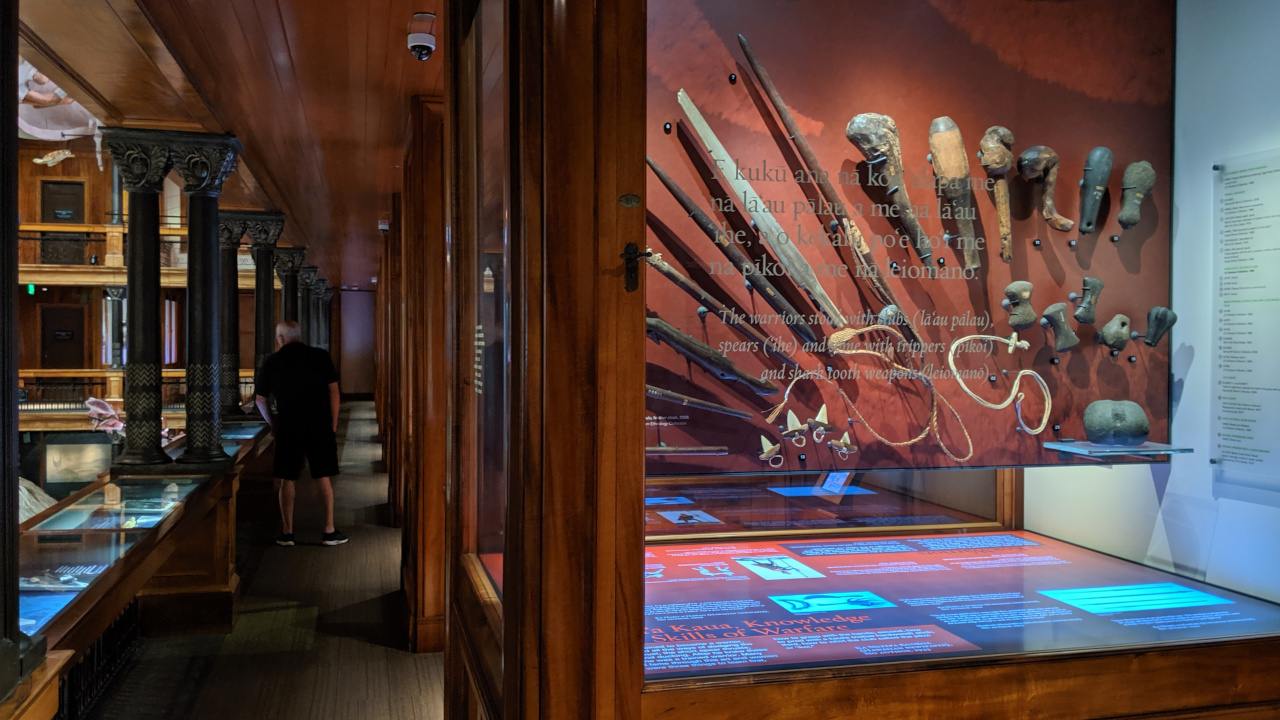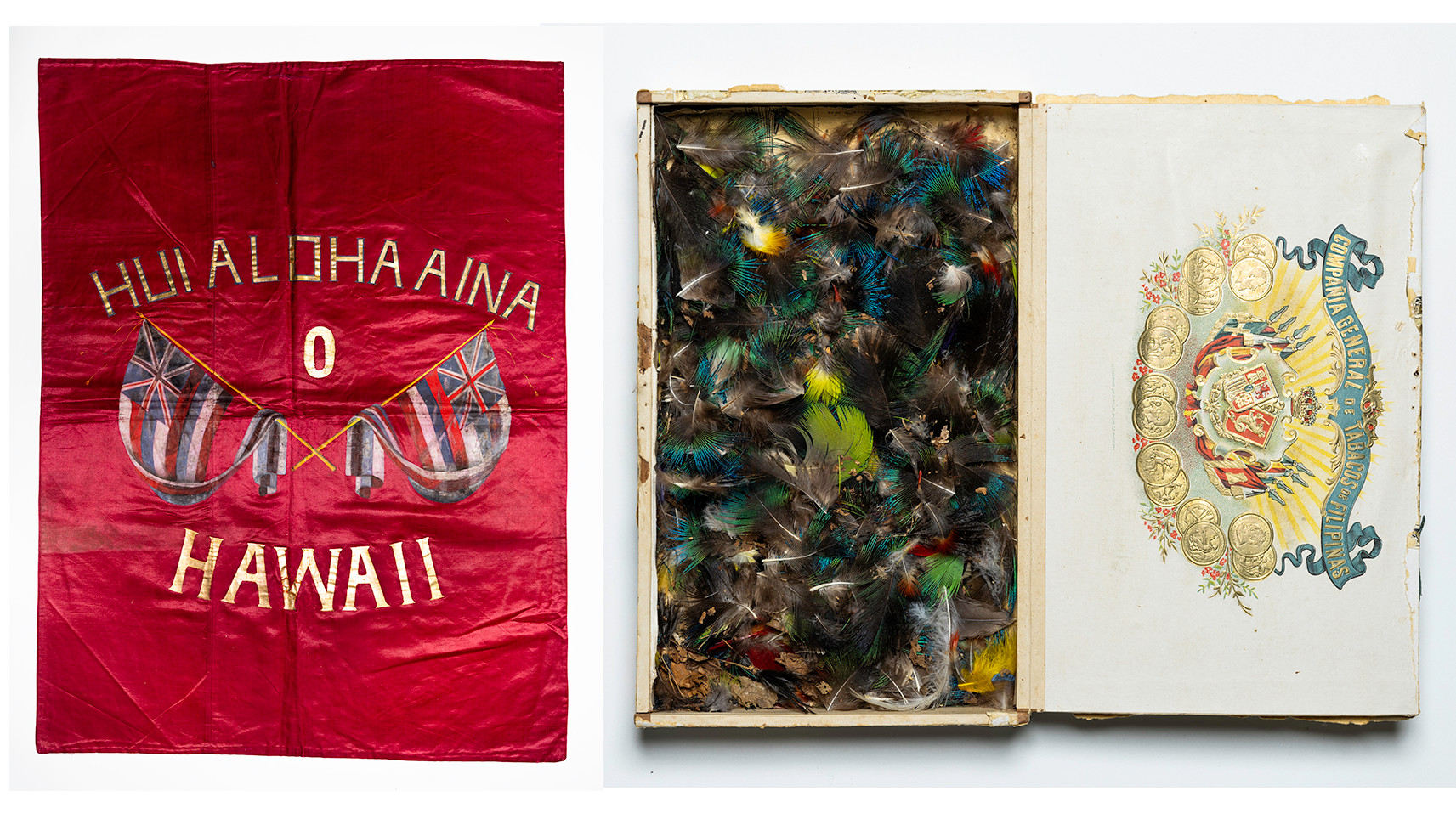(BIVN) – Bishop Museum on Oʻahu is opening a new exhibition, Kū a Lanakila! Expressions of Sovereignty in Early Territorial Hawaiʻi, 1900-1920 in the J. M. Long Gallery in Hawaiian Hall.
The exhibit, with links to Hawaiʻi island, shares how Native Hawaiian people “proudly affirmed their continuity in the face of American imperialism”, museum promotional materials say.
“It can be said that the discourse around Hawaiian sovereignty has occurred for as long as the Hawaiian islands were ʻdiscovered’ by visitors from other lands,” said Sarah Kuaiwa, Ph.D., Bishop Museum curator for Hawaiʻi and Pacific Resources, and Kū a Lanakila! curator. “Many are familiar with the 1893 overthrow of Queen Liliʻuokalani and 1898 annexation of the islands, both viewed as illegal acts, that continue to inspire calls for redress in the present day. Some may not know, however, that during the beginnings of American governance in Hawaiʻi, there was a similar movement throughout the islands.”
From a Bishop Museum news release:
In the first two decades of Hawaiʻi’s territorial period, which spanned 1900-1959, Kanaka ʻŌiwi (Native Hawaiian people) proudly affirmed their continuity in the face of American imperialism by celebrating aspects of Hawaiian culture through political campaigns, pageantry, competitive sports, and ceremony. Kū a Lanakila! highlights the inextricable link between Hawaiian cultural outlets and language with civic and political engagement during this contested period.
“Bishop Museum’s vast collections offer opportunities to tell underrecognized stories about Hawaiʻi and its people,” said Kuaiwa. “This exhibition showcases the organizational and cultural efforts spearheaded by Kanaka ʻŌiwi between 1900-1920, a period characterized by extensive and intentional community organizing across the islands. The objects featured in Kū a Lanakila! are physical representations of Kanaka ʻŌiwi charity, ceremony, competition, and campaigning.”
The exhibition is framed by two important years, 1900 and 1920.
The Hawaiian Organic Act of 1900 transferred Hawaiʻi’s political sovereignty to the United States. Kanaka ‘Ōiwi accounted for two-thirds of the new territory’s eligible voters, enabling them to retain a remarkable amount of influence in local elections. This momentum was used to generate support for Kanaka ‘Ōiwi politicians while also bringing to light social causes affecting Native Hawaiian people.
A culminating moment for Kanaka ʻŌiwi was the introduction of the Hawaiian Homes Commission Act (HHCA) to the U.S. Congress in 1920, by Prince Jonah Kūhiō Kalanianaʻole. The HHCA, which was signed into legislation by President Harding in 1921, aimed to set aside home lands for Kanaka ʻŌiwi. The introduction and passage of HHCA is not only one of Kūhiō’s major political achievements, but represents decades of tireless work by the Prince in Washington, D.C. and Kanaka ‘Ōiwi at home to support the lives of Native Hawaiians.
Kū a Lanakila! Expressions of Sovereignty in Early Territorial Hawaiʻi, 1900-1920 features objects from Bishop Museum’s Library & Archives and Ethnology collections, including Hui Aloha ʻĀina Banners (banners representing the Hawaiʻi, Maui, and Kauaʻi branches of Hui Aloha ‘Āina); ceremonial adornments made and used by ʻAhahui Kaʻahumanu (Kaʻahumanu Society); and political ribbons and ephemera supporting Prince David Kawānanakoa and Prince Jonah Kūhiō Kalanianaʻole.
Perhaps the exhibition’s most notable feature is the 40-foot Aʻa, Prince Kūhiō’s racing canoe.
Hawaiʻiʻs monarchs sponsored aquatic sports competitions in the late-19th century, and the spirit of aliʻi’s support for aquatic sports, especially paddling, persisted into the Territory period. Prince David Kawānanakoa and Prince Jonah Kūhiō Kalanianaʻole participated in six-man canoe racing while also running for political office, bridging athletics and politics together.
“Prince Jonah Kūhiō Kalanianaʻole’s koa racing canoe, Aʻa, was built in 1902 by Henry Weeks and his assistant Antone Grace in Kona,” said Kuaiwa. “It was then brought to Honolulu to compete in six-man canoe races at a time when the sport’s popularity was growing. In its heyday, Aʻa was paddled and steered by a crew of Kona paddlers. Races won by the Kona crew brought immense pride to Kanaka ʻŌiwi across the islands.”
After Prince Kūhiō’s passing in January 1922, Aʻa was gifted to the Bishop Museum in 1923 as part of the Kapiʻolani-Kalanianaʻole Collection. Bishop Museum currently co-stewards Aʻa with the Dowsett ʻOhana, who have generously overseen the physical care and restoration of the canoe since 1952.
The exhibition features a festive landscape painting and diorama to help viewers imagine A’a in Oʻahu’s Honolulu Harbor.
“I am very inspired by the vast collections we have here at Bishop Museum, many of which deserve more attention, recognition, and connection with the communities they represent,” said Kuaiwa. “Many of the pieces in Kū a Lanakila! were donated by individuals and families who have entrusted the Museum with these important histories. I find their gifts to the Museum very moving and inspiring and I feel very fortunate to be able to share them through this exhibition.”
“I ka wā mamua, i ka wā mahope. The future is made possible by the past, and I hope visitors can draw inspiration and strength from the pieces and histories in Kū a Lakanila!, shared Kuaiwa. “I think there are a lot of parallels between the first two decades of the 20th century and the first two decades of the 21st century.”
Kū a Lanakila! Expressions of Sovereignty in Early Territorial Hawaiʻi, 1900-1920 opens in Bishop Museum’s J. M. Long Gallery on Saturday, Oct. 5, 2024 and runs through Aug. 10, 2025. The exhibition is curated by Sarah Kuaiwa and designed by Brad Evans, with graphic design work by Susan Yamamoto.



by Big Island Video News7:17 am
on at
STORY SUMMARY
HONOLULU - The new exhibition, "Kū a Lanakila! Expressions of Sovereignty in Early Territorial Hawaiʻi, 1900-1920", features stories with links to Kona.